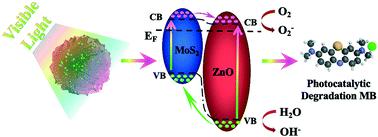当前位置:
X-MOL 学术
›
CrystEngComm
›
论文详情
Our official English website, www.x-mol.net, welcomes your
feedback! (Note: you will need to create a separate account there.)
Construction of an MZO heterojunction system with improved photocatalytic activity for degradation of organic dyes
CrystEngComm ( IF 2.6 ) Pub Date : 2020-09-15 , DOI: 10.1039/d0ce00581a Yingnan Quan 1, 2, 3, 4, 5 , Rui Su 1, 2, 3, 4, 5 , Mingyue Hu 1, 2, 3, 4, 5 , Jihui Lang 1, 2, 3, 4, 5 , Hougang Fan 1, 2, 3, 4, 5 , He Shen 1, 2, 3, 4, 5 , Ming Gao 1, 2, 3, 4, 5 , Baizhi Li 3, 4, 6, 7 , Yang Liu 1, 2, 3, 4, 5 , Jinghai Yang 1, 2, 3, 4, 5
CrystEngComm ( IF 2.6 ) Pub Date : 2020-09-15 , DOI: 10.1039/d0ce00581a Yingnan Quan 1, 2, 3, 4, 5 , Rui Su 1, 2, 3, 4, 5 , Mingyue Hu 1, 2, 3, 4, 5 , Jihui Lang 1, 2, 3, 4, 5 , Hougang Fan 1, 2, 3, 4, 5 , He Shen 1, 2, 3, 4, 5 , Ming Gao 1, 2, 3, 4, 5 , Baizhi Li 3, 4, 6, 7 , Yang Liu 1, 2, 3, 4, 5 , Jinghai Yang 1, 2, 3, 4, 5
Affiliation

|
Constructing heterojunctions is an effective strategy to improve photocatalytic activity. Here, we designed and synthesized MoS2/ZnO (MZO) heterojunction nanocomposites for photocatalytic degradation of organic dye pollutants. This work explores two main parts: exploring the formation mechanism of MZO and studying the photocatalytic performance of MZO. The results show that the heterostructure exhibits higher photocatalytic activity than pure MoS2 based on the synergistic effect of dipole–dipole coupling and charge transfer. Within 40 minutes, more than 97% of organic dyes can be degraded by the MZO photocatalyst. The degradation rates were 7, 11 and 10 times those of pure MoS2, ZnO and P25 photocatalysts, respectively. Such photocatalysts also exhibit excellent reusability and stability. Therefore, this study provides an effective strategy for photocatalytic degradation of organic dyes, which is very promising in the field of environmental treatment.
中文翻译:

具有改善的光催化活性以降解有机染料的MZO异质结系统的构建
构建异质结是提高光催化活性的有效策略。在这里,我们设计和合成了MoS 2 / ZnO(MZO)异质结纳米复合材料,用于光催化降解有机染料污染物。这项工作探索了两个主要部分:探索MZO的形成机理和研究MZO的光催化性能。结果表明,基于偶极-偶极耦合和电荷转移的协同效应,异质结构比纯MoS 2具有更高的光催化活性。在40分钟内,MZO光催化剂可降解超过97%的有机染料。降解速率是纯MoS 2的7、11和10倍,ZnO和P25光催化剂。这种光催化剂还显示出优异的可重复使用性和稳定性。因此,本研究为光催化降解有机染料提供了有效的策略,这在环境处理领域非常有前途。
更新日期:2020-10-11
中文翻译:

具有改善的光催化活性以降解有机染料的MZO异质结系统的构建
构建异质结是提高光催化活性的有效策略。在这里,我们设计和合成了MoS 2 / ZnO(MZO)异质结纳米复合材料,用于光催化降解有机染料污染物。这项工作探索了两个主要部分:探索MZO的形成机理和研究MZO的光催化性能。结果表明,基于偶极-偶极耦合和电荷转移的协同效应,异质结构比纯MoS 2具有更高的光催化活性。在40分钟内,MZO光催化剂可降解超过97%的有机染料。降解速率是纯MoS 2的7、11和10倍,ZnO和P25光催化剂。这种光催化剂还显示出优异的可重复使用性和稳定性。因此,本研究为光催化降解有机染料提供了有效的策略,这在环境处理领域非常有前途。











































 京公网安备 11010802027423号
京公网安备 11010802027423号